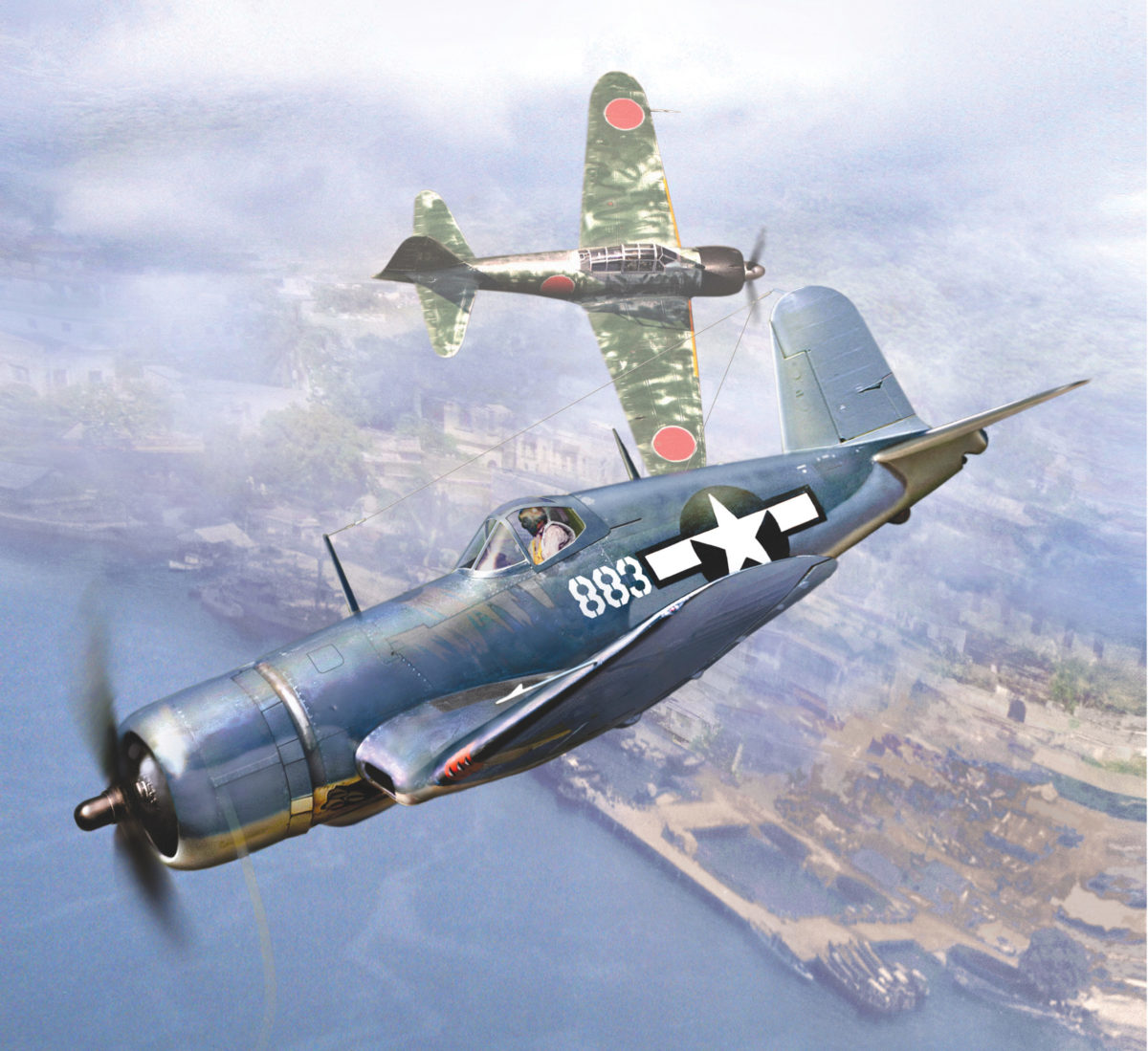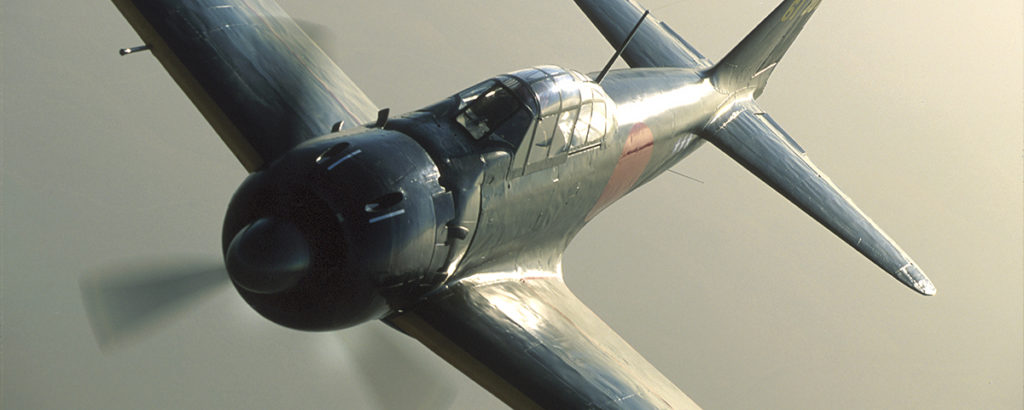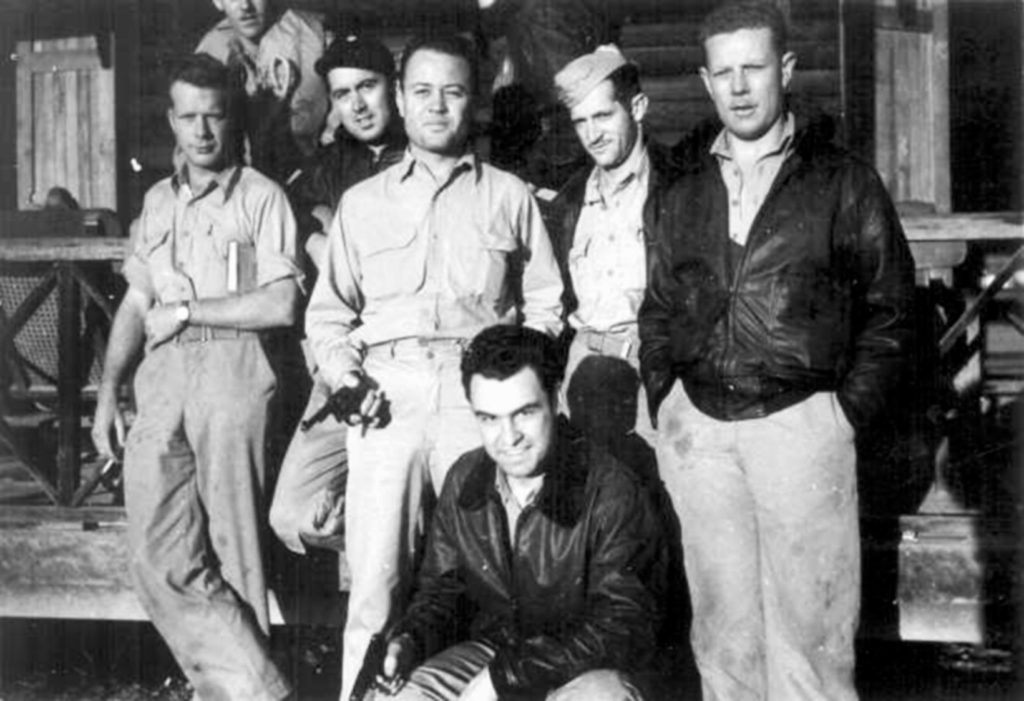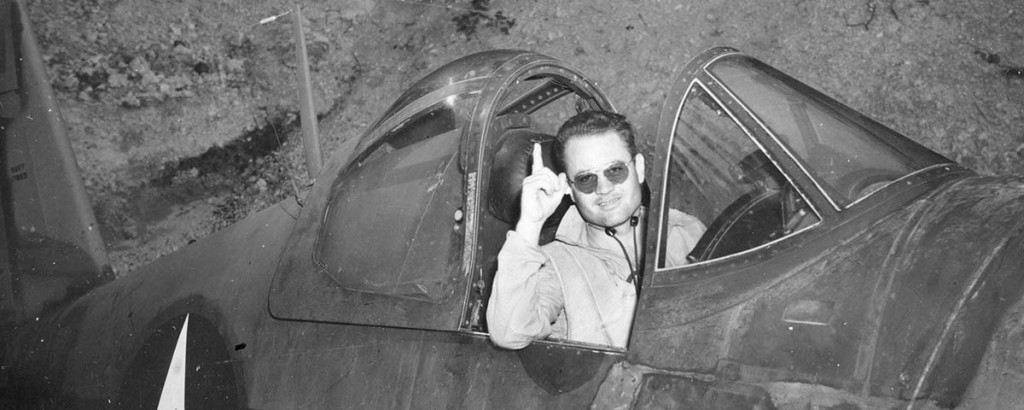It was one of the biggest air raids in the entire campaign for the Solomon Islands. More than a year after U.S. Marines landed on Guadalcanal, Navy TBF Avengers and SBD Dauntless dive bombers were to hit the Japanese base on Ballale, at the far end of the island chain, on September 16, 1943. Navy F6F-3 Hellcats and Royal New Zealand Air Force P-40 Kittyhawks flew cover. And way up over 20,000 feet—either for altitude advantage or their own protection—were some two-dozen Marines. VMF-214 was a newly reorganized squadron on just its third mission, and flying an ill-starred fighter to boot: the Vought F4U-1 Corsair, or “Bent-Wing Bird.”
High atop the four-mile-tall array, squadron commander Major Gregory Boyington was feeling sorry for himself. Without victories, his cobbled-together squadron of shiny new lieutenants and disbanded-unit orphans would soon be washed back into the replacement pool. In his 1958 memoir, Baa Baa Black Sheep, Boyington admitted he almost didn’t notice when the rest of the massive U.S. formation suddenly dived under a layer of stratus. “What in hell goes?” he muttered. “We must be over the mission.”
Following him down, the other Corsair pilots found the bombers pounding Ballale and dozens of Japanese fighters coming up to do battle. Boyington was suddenly amazed to see, not 30 feet away, a red-balled A6M Zero practically flying on his wing. That’s when he realized he had completely forgotten to switch on his gunsight and guns.
Most Americans think of “Pappy” Boyington as actor Robert Conrad portrayed him in the TV series Baa Baa Black Sheep, yet even that nickname was invented by the press. In the Solomons his pilots called the 30- year-old major “Gramps.” After claiming six victories in China while piloting P-40s with the American Volunteer Group—but only being credited with two by the Flying Tigers—Boyington had arrived in the Solomons just as the Marines replaced their Grumman F4F-4 Wildcats with new Corsairs.
Designed behind a bombersize prop more than 13 feet across (the inverted gull wings and long nose were necessary to give it ground clearance), the F4U was the first American single-engine plane to average more than 400 mph, but it was prone to unrecoverable spins and landing stalls, and that “hose nose” blocked the pilot’s vision on straight-in carrier approaches. The Navy judged it unfit for shipboard ops, but good enough for the Marines. In Boyington’s opinion: “The Corsair was a sweet-flying baby if I ever flew one. No longer would we have to fight the Nips’ fight, for we could make our own rules.”
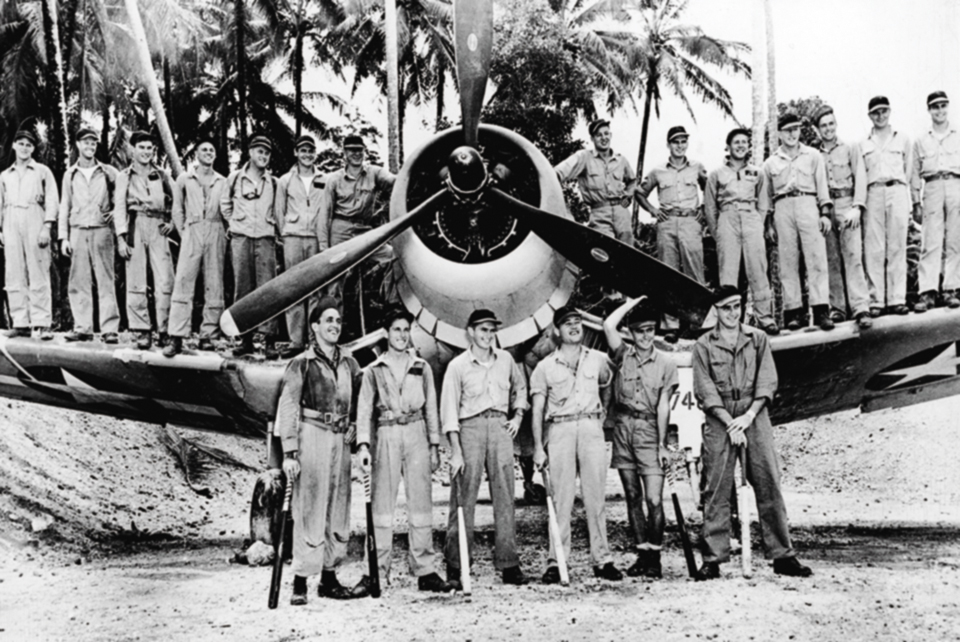
He made his own squadron, too. Later portrayed on TV as misfits and rejects awaiting courts-martial, the “Black Sheep” (the first choice, “Boyington’s Bastards,” was nixed as not press-friendly) were in fact among the most experienced pilots in the theater. Even the rookies had accumulated high flight hours, and the outfit’s 10 veterans included several with more victories than Boyington. Though they had flown together only briefly before September 16, the results of that first day of combat were unequivocal.
At the debrief after the mission, Lieutenant Bob McClurg reported getting his first kill in a head-on pass: “I just held the trigger down as we came at each other. I was scared to death.” Boyington’s wingman, Lieutenant Don Fisher, scored two, including one that he shot off his leader’s tail. “I was right behind [the Zero], and he blew,” Fisher recounted. “The wings went each way.” But he had lost sight of Gramps, who was hours overdue returning to base. VMF- 214 had almost marked Boyington MIA when his Corsair at last arrived and he climbed out of the cockpit, claiming no fewer than five kills—even discounting his AVG victories, an ace in a day.
GET HISTORY’S GREATEST TALES—RIGHT IN YOUR INBOX
Subscribe to our HistoryNet Now! newsletter for the best of the past, delivered every Monday and Thursday.
After reportedly maneuvering the first Zero into an overshoot (and charging his guns), Boyington had sent it down in flames, then gunned down enemy fighters halfway back home, including one that “exploded completely when I was about 50 feet from him.” Too close to evade, he had flown directly through the explosion, somehow dodging the pilot, engine and still-spinning prop.
There was no gun camera film in those days; Boyington had only his word to back up his claims. But he had stopped off at the recently captured forward air base at Munda, on New Georgia, almost out of gas and ammo, with dents all over his Corsair from flying debris. His kills—almost half the squadron score of 11 (plus eight probables)— were confirmed. Within a few weeks, propelled by the CO’s Flying Tiger back story and the Marine Corps press machine, the Black Sheep were a household name. And they were just getting started.
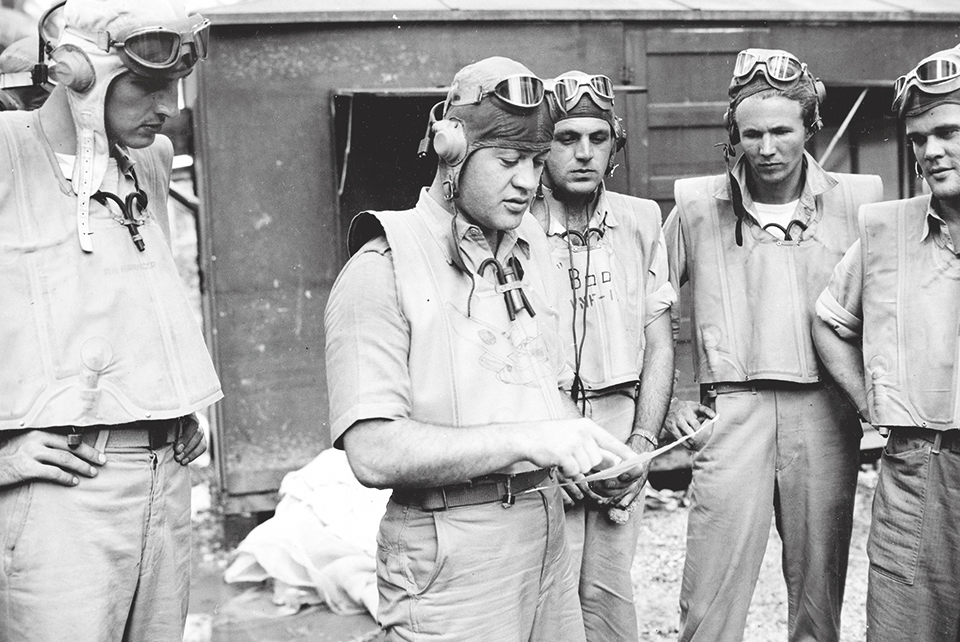
Lieutenant Bill Case had only scored a probable over Ballale. One week later he held his fire to within 50 feet of a Zero’s tail—too close— and rounds from his Corsair’s six wide-set wing guns straddled its fuselage. “I spent about 2,000 rounds figuring that out,” said Case, as quoted in Bruce Gamble’s 1998 book The Black Sheep. “I finally put the pipper up above his tail and about 6 to 8 feet to the side…and hit him with three guns at a time.”
Lieutenant John Bolt had missed his first kill over Ballale. “The first time I saw a meatball it was a full deflection shot, and he just zipped by,” he reported. “I was in a state of shock.” Over Vella Lavella, however, Bolt got behind two Zeros in succession, flaming both for a double kill.
Lieutenant Chris Magee had likewise been flummoxed by the speed of air combat: “All I could do was keep spinning my neck and looking…everything was happening so fast.” Called “Maggie” (though rarely to his face, as he was a dedicated weightlifter and fitness fanatic), Magee plunged from 13,000 feet into a pack of Aichi D3A2 “Val” dive bombers attacking a U.S. convoy. “The Japanese were going into a straight dive, so I headed into the dive with them,” he recalled. “Of course, by then the [American] antiaircraft was all around us, but you don’t even think of that….The [Vals] kept going down, and I kept in there, firing.” By the time they pulled out above the water, he had splashed two, and a third probable, when he heard bullets striking his plane “like a hail storm on a tin roof.” The Vals’ escort—Zeros, always slow in a dive—had caught up. Magee made it back to base with 30 bullet holes in his Corsair. He was recommended for a Navy Cross, and his nickname changed to “Wild Man.”
During the late 1943 island-hopping campaign up the Solomons,VMF-214 flew out of bases so far forward that they were often behind Japanese lines. (Navy Seabees had started the reconstruction of desolate, bomb-pocked Munda while the enemy still held the far end of the strip.) On their first tour, the Black Sheep suffered an almost 40 percent casualty rate, including one pilot shot down in a friendly-fire duel with Navy PT-boats. Yet they overflew Bougainville so regularly that the Japanese, via radio, dared Boyington by name to come down and brave the anti-aircraft; instead he taunted Zero pilots that they should come up and fight. John Bolt even flew an unauthorized one-man air raid on Tonolei Harbor, making two strafing runs on troop transports and boat traffic. “I was only taken under fire from one gun,” he reported to a furious Boyington on his return, adding that its 20mm tracers “just floated by.” Despite his CO’s ire, Bolt received a congratulatory telegram from no less than Admiral William “Bull” Halsey, plus the Distinguished Flying Cross. He would eventually earn a Navy Cross as well.
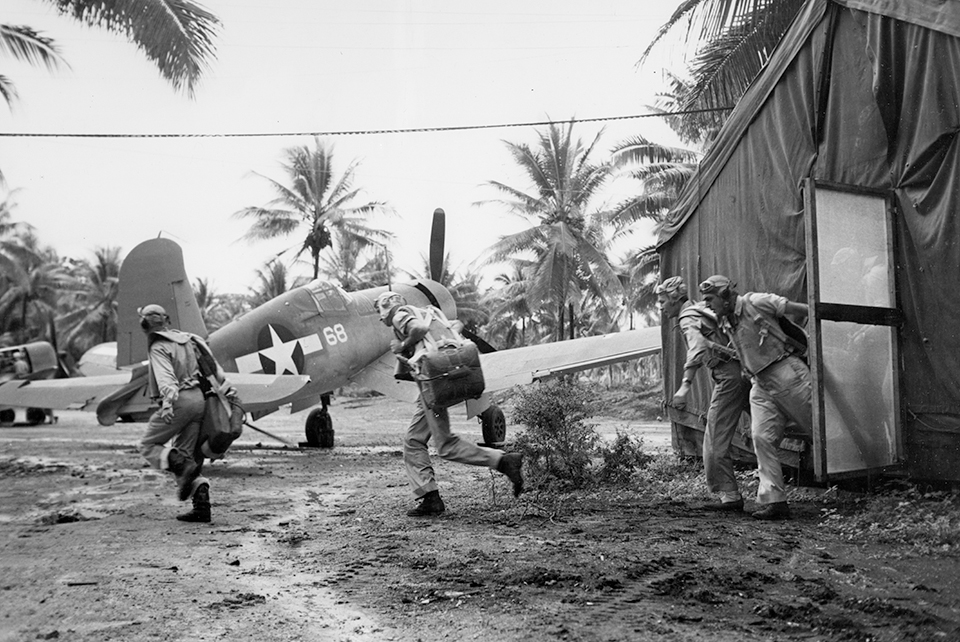
In six weeks VMF-214 scored 57 kills, with 19 probables. Wild Man Magee claimed seven. Bill Case finished with eight. On his last mission, for no real reason Case lowered his cockpit seat a notch; when a 7.7mm bullet pierced his canopy, instead of drilling him through the skull, it merely creased his scalp.
Halsey visited VMF-214’s base to shake hands all around. Boyington was nominated for the Medal of Honor. At a November photo op on Espiritu Santo, a Corsair was dressed up with his name and 20 Japanese victory flags, though in fact it was a point of pride in the squadron that they all shared airplanes; not even Boyington flew a personal mount. Hero-hungry America couldn’t get enough of the Black Sheep. Neither could the Marine Corps, which boosted squadron pilot strength from 28 to 40.
Recommended for you
On November 1, the Allies finally landed on Bougainville, capturing just enough beachhead for a staging field at Torokina. For the first time Allied fighters could reach Rabaul, the “Pearl Harbor of the Southwest Pacific.” Within shooting distance of 26 victories—the American record held since World War I by Eddie Rickenbacker, only recently tied by Captain Joe Foss—Boyington led a fighter sweep, marking the first appearance by American single-engine planes over Simpson Harbor. (When a Navy squadron commander questioned his tactics, Boyington snapped: “Tactics? Hell, you don’t need any tactics. When you see the Zeros, you just shoot ’em down, that’s all.”) Against such an armada, however, the Americans found few Zeros willing to fly. McClurg broke formation to dive after a Nakajima A6M2-N “Rufe” floatplane, his fourth kill: “He was sitting there just flying straight and level. Nothing to it….[Boyington] looked over at me shaking his fist at me for breaking formation.” But the CO himself went down alone to strafe the air base at Lakunai. “We scared them,” he declared. “We ought to send up only about 24 planes, so they’d be sure to come up and fight.”
A week later the Allies sent two dozen B-24 Liberators—but backed up by nearly 100 Corsairs, Hellcats, Kittyhawks and Army P-38 Lightnings. This time the Japanese matched them fighter for fighter. In this titanic dogfight over Rabaul the Black Sheep lost three but claimed 12, Bolt and McClurg getting doubles to become aces, Magee raising his total to eight. And Boyington got four, at one point taking on a nine-plane formation all by himself: “I came down unknown to the Zekes and picked off the tail-end man, and then ran like a sonof-a-gun.” He even made a strafing run on a Japanese sub he caught on the surface. It was his second-best day ever as a Black Sheep.
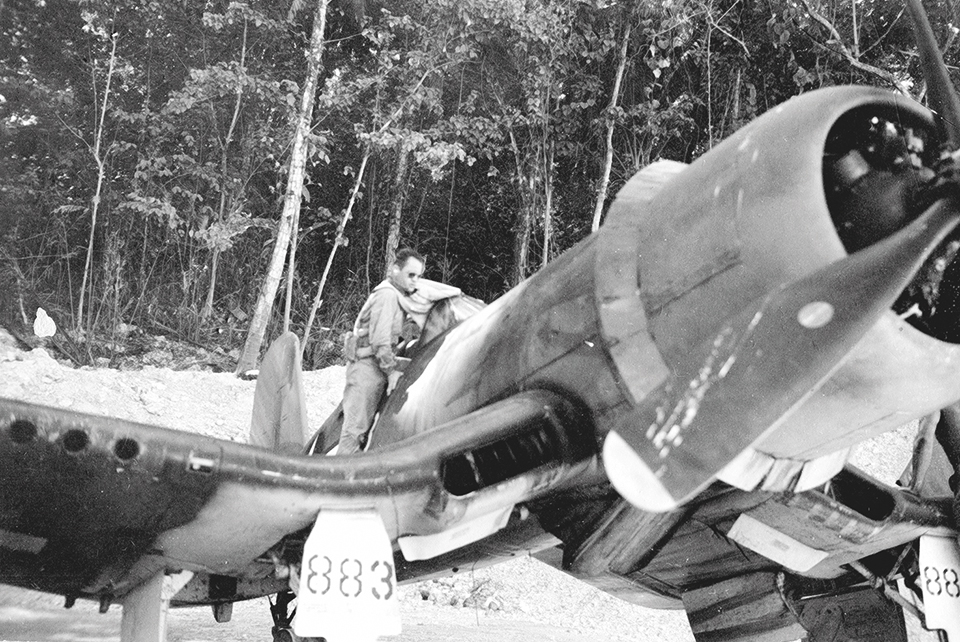
The closer he came to the record, however, the more he seemed to feel the weight of history bearing down on him. He gave reporters wave-offs and brusque replies: “I didn’t come out here to make news. I came out here to fight a war.” McClurg got his seventh, Magee his ninth and Don Fisher got a double to become an ace, but Boyington stalled. “The hunting was fine,” he said of those last days of 1943, “…but I’m doing some dumb things up there!” He scored one more Zeke over Rabaul, but the next day was outflown by an enemy plane he reported as a Nakajima Ki-44 “Tojo” that got away, scored only as a probable. On a subsequent mission he had to turn back with his windscreen covered in oil; at one point, as several fellow pilots attested, he undid his straps and stood up into the slipstream to wipe it off.
“Don’t worry about me,” he told his men. “If you guys ever see me going down with 30 Zeros on my tail, don’t give me up. Hell, I’ll meet you in a San Diego bar and we’ll all have a drink for old times’ sake.” They celebrated New Year’s Eve Black Sheep style, firing so many pistol flares that the transport fleet offshore got underway, fearing an air raid.
On January 3, 1944, Boyington led another sweep to Rabaul. The Japanese saw the Americans coming and sent up some 70 fighters to intercept. Boyington led the charge down into them. “I poured a long burst into the first enemy plane that approached,” he said. The Zero burst into flames, and several pilots saw it go down—Boyington’s record-tying 26th victory. But they lost sight of Gramps in the low-level haze, where he found some 20 enemy fighters waiting. Word of his record kill preceded him back to base. “There was a radio recording hookup,” remembered one Black Sheep, “and the Marine Corps and Navy photo sections had cameramen there.” Elation turned to shock when Boyington failed to return. “In the movies it would be labeled pure corn,” wrote one correspondent. “Things like that don’t happen.”
Bolt got his sixth the next day, but adding insult to grievous injury, with its tour finished, VMF-214 was broken up and scattered for reassignment. A reconstituted unit did not fare so well on its return to combat. In August 1945, the survivors were preparing to muster out when word came that Boyington was not only alive but now considered the top-scoring Marine ace of the war, having claimed two more Zeros on his last mission before going down in the ocean. (Today official sources credit him variously with between 24 and 28 victories.) He’d been picked up by a Japanese sub, and spent the rest of the war as a POW. That October on the White House lawn, President Harry S. Truman awarded Boyington his “posthumous” Medal of Honor, but not before Pappy had his promised reunion with the Black Sheep—one so legendary that it’s said to have been the first bender to rate a photo feature in Life magazine.
What America knows as the Black Sheep Squadron flew together as a unit for only about three months—less than one 13-week television season—but destroyed 97 enemy aircraft, with 35 probables and 50 damaged, plus almost 30 ships sunk. Of the 28 pilots on their first tour, no fewer than nine became aces. Bolt went on to score six kills in Korea for 12 total—the Marine Corps’ only jet ace and only ace in two wars—while Magee flew Messerschmitts for the Israelis, bootlegged booze and robbed banks. One of the few WWII-vintage squadrons still serving today, VMF-214 flew Corsairs in Korea, A-4 Skyhawks in Vietnam and AV-8B Harrier jump jets in Iraq and Afghanistan. Over the years the forlorn black sheep on the squadron insignia, which a bunch of orphan flyboys first scribbled up on Guadalcanal, has become a proud, foot-stamping ram. And no matter what they fly, their crest still bears a Bent-Wing Bird.
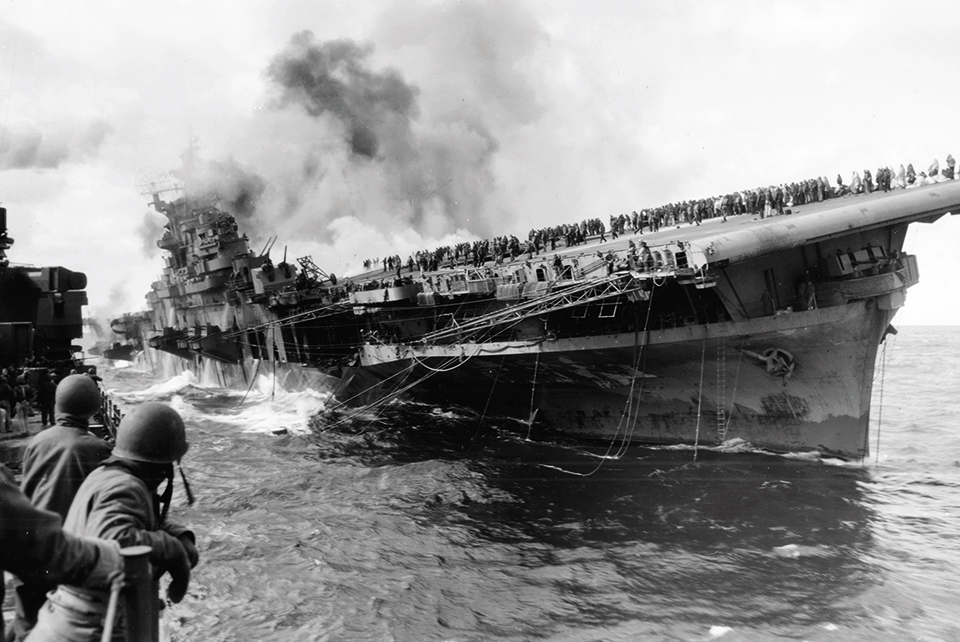
For further reading, frequent contributor Don Hollway recommends Baa Baa Black Sheep, by Gregory “Pappy” Boyington (“more for flavor than accuracy”); Bruce Gamble’s The Black Sheep and Swashbucklers and Black Sheep; and Once They Were Eagles, by VMF-214 intelligence officer Frank Walton. To view related video and additional photographs, visit donhollway.com/blacksheep.
Originally published in the January 2014 issue of Aviation History. To subscribe, click here.

